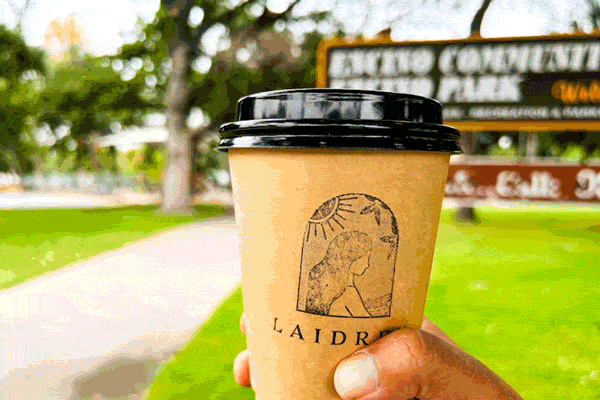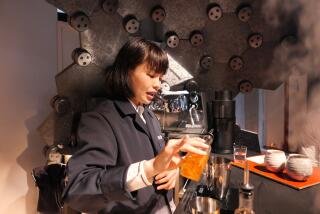Espresso Yourself!
- Share via
Tired of the annoying baristas in your favorite java joint who seem more concerned with the pretty young thing next to you--or their own reflections in the mirror--than with your decaf nonfat latte with no foam? Take matters into your own hands.
No, don’t strangle that struggling actor. Buy yourself a real espresso machine for the home.
It’s definitely a trend. The number of home espresso machines is small but growing, and it’s highest in our part of the country, says Ted Lingle, executive director of the Specialty Coffee Assn., based in Long Beach. “Inch by inch, espresso is becoming the beverage of choice of coffee drinkers, even at home,” he says. “Once you get hooked on the taste of espresso, it’s hard to go back to regular coffee.”
Some people are so addicted that they travel with machines. Members of the King Crimson rock band carry the Estro Profi in its “Cafe Crim” traveling valet, an indestructible road case. (Bassist Tony Levin handles espressos while guitarist Robert Fripp takes charge of cappuccinos.)
The espresso method of making coffee--in which boiling water is forced through the coffee grounds at high pressure--was invented in Italy at the turn of the century; machines that use electric pumps, rather than mere steam, became available in the ‘40s. More of the solids are extracted by the espresso process, meaning you end up with more of the bean in the cup.
For a perfect cup, you need nine atmospheres of pressure, says Timothy J. Castle, author of a book called “Perfect Cup: A Coffee Lover’s Guide to Buying, Brewing & Tasting” (Addison-Wesley, 1991). Steam alone won’t provide that--which is why the classic Italian stove top models don’t make the best espresso. Also skip machines costing less than $100--they’re strictly steam driven too. Expect to pay $200 to $500 or more for a quality machine.
The milk foaming process goes like this, says Wilfrid Ward Jr., manager of a Starbucks in West Hollywood: Use very cold milk (the percentage of fat doesn’t affect how well it will foam), and hold the nozzle of your machine right at the milk’s surface, where it will make a gurgling sound (don’t fill the milk to the top of the container or it will boil over immediately). Once the foam rises to the top, thrust the nozzle down to the bottom to fully heat the milk.
And steam the milk before you make the espresso: a cup of hot milk will retain heat longer than one or two ounces of espresso.
Anyone can try out a machine at Starbucks before buying, and it’s definitely an education.
Newest on the market is Illy’s X-1 machine ($500). Designed by Italian architect and designer Luca Trazzi, it looks like something from the Jetsons’ home. This machine uses pre-measured, prepackaged “pods” of Illy espresso (sold in tins of 18 for about 50 cents a pod), meaning no loose coffee grounds, no mess and no fuss. It’s basically idiot-proof, a concept that can go far at home. Purists will argue that only fresh-roasted, fresh-ground coffee is worth drinking, but after a few tries at this machine, you may be convinced otherwise. (If you must have fresh-ground coffee, a separate filter holder can be purchased.)
The Proteo Barista ($349), is available at Starbucks everywhere (and I do mean everywhere!) and, Ward says, ranks as the favorite among employees. Its “gran-crema portafilter” is supposed to adjust automatically to any grind, and the machine forces the water through the coffee with extra pressure to make good crema, the layer of light foam (made up of tiny bubbles of carbon dioxide forced out of the grounds by the pressure of the steam) that appears atop good espresso. The machine is simple to use, though it does make a small mess.
Less expensive, also at Starbucks, is the Proteo Grande ($269), stylish in cobalt blue. Not quite as powerful as the Barista, the Grande will work fine for most people who just want to make a quick cup or two in the morning.
Krups Espresso Novo 3000 Pro Crema ($249) is a delight to use. Even the first time out, it steams milk perfectly, perhaps because of its patented “perfect froth” attachment. Three settings on the filter holder accommodate varying amounts and grinds of espresso. And the push-button, auto-eject feature for used grounds mostly works well, except when the grounds retain too much water and are a bit messy.
Krups’ Nespresso System ($500), available through Williams-Sonoma ([800] 541-2233), uses pre-measured espresso capsules, much like the (incompatible) Illy machine with its pods. Krups’ sleek, attractive design is a plus, but--as with the Illy machine--the capsules (about 50 cents each) may offend purists.
Coffee is 98% water, so the water going into your espresso makes a big difference. Use bottled or filtered water, never tap. You also need a fine, even grind to make proper espresso. If you don’t want to spend another $50 or more on a quality burr grinder, purchase your beans in small quantities and have them ground for espresso where you buy them.
More to Read
Eat your way across L.A.
Get our weekly Tasting Notes newsletter for reviews, news and more.
You may occasionally receive promotional content from the Los Angeles Times.










